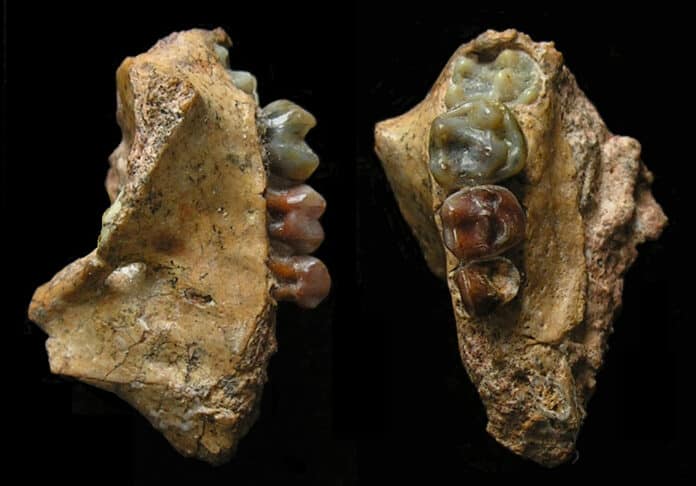Hylobatids- a family of apes that includes 20 species of living gibbons, are found throughout tropical Asia from northeastern India to Indonesia. The fossil record of the hylobatids is poorly known. Most specimens are isolated teeth and fragmentary jaw bones found in cave sites in southern China and Southeast Asia dating back no more than 2 million years ago.
Recently, a finding from a team of scientists could fill a gap in the evolutionary history of apes. Scientists from New York University have discovered the earliest gibbon fossil in the Yuanmou area of Yunnan Province in southwestern China. The fossil is of a small ape called Yuanmoupithecus xiaoyuan.
The study mainly focused on the teeth and cranial specimens of Yuanmoupithecus, which included an upper jaw from an infant less than 2 years old at the time of its death. Using the size of the molar teeth as a guide, the scientists estimate that Yuanmoupithecus was similar in size to today’s gibbons, with a body weight of about 6 kilograms—or about 13 pounds.
Terry Harrison, a professor of anthropology at New York University and one of the paper’s authors, said, “This new find extends the fossil record of hylobatids back to 7 to 8 million years ago and, more specifically, enhances our understanding of the evolution of this family of apes.”
“The teeth and the lower face of Yuanmoupithecus are very similar to those of modern-day gibbons, but in a few features, the fossil species was more primitive and points to it being the ancestor of all the living species.”
Xueping Ji of the Kunming Institute of Zoology and the lead author of the study found the infant’s upper jaw during his field survey. He identified it as a hylobatid by comparing it with modern gibbon skulls in the Kunming Institute of Zoology. He invited Harrison and other colleagues to work on specimens that were amassed over 30 years and kept at the Yuanmou Man Museum and the Yunnan Institute of Cultural Relics and Archaeology in 2018.
Harrison said, “The remains of Yuanmoupithecus are scarce, but with diligence, it has been possible to recover enough specimens to establish that the Yuanmou fossil ape is indeed a close relative of the living hylobatids.”
The study also reported that Kapi ramnagarensis, which has been claimed to be an earlier species of hylobatid based on a single isolated fossil molar from India, is not a hylobatid after all but a member of a more primitive group of primates that are not closely related to modern-day apes.
Harrison cautions, “Genetic studies indicate that the hylobatids diverged from the lineage leading to the great apes and humans about 17 to 22 million years ago, so there is still a 10-million-year gap in the fossil record that needs to be filled. With the continued exploration of promising fossil sites in China and elsewhere in Asia, it is hoped that additional discoveries will help fill these critical gaps in the evolutionary history of hylobatids.”
Journal Reference:
- Xueping Ji et al. The earliest hylobatid from the Late Miocene of China. Journal of Human Evolution. DOI: 10.1016/j.jhevol.2022.103251
